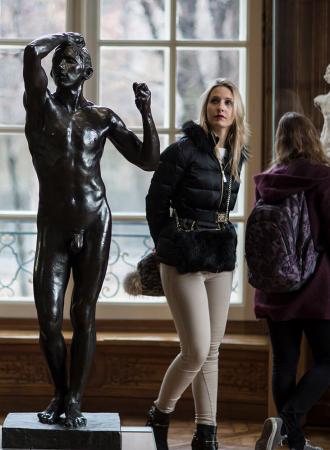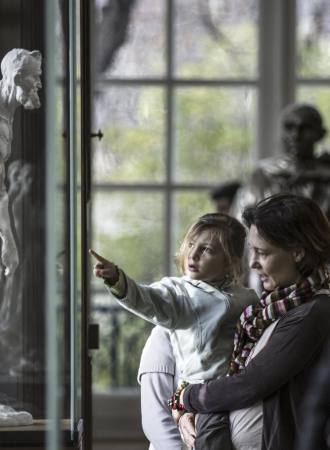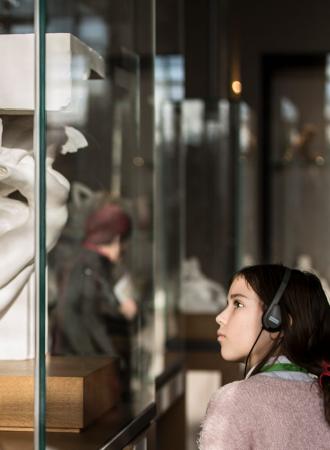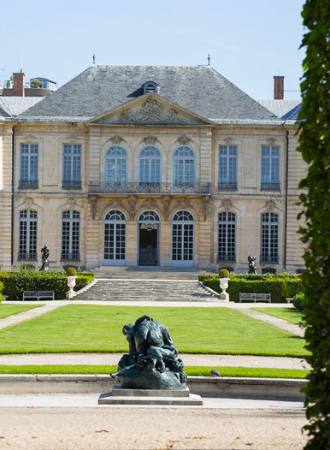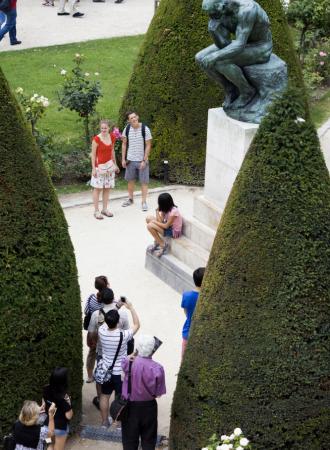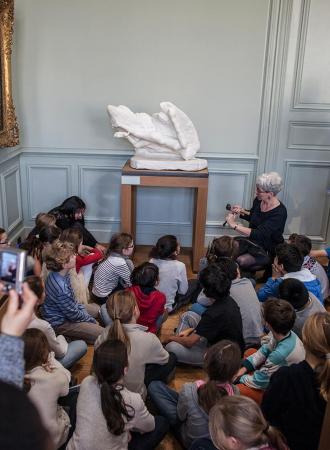Search the site
Camille Claudel
A photograph dating from 1899 shows Camille Claudel, then aged 45, in her studio, wrapped in a long dark coat, standing opposite Perseus and the Gorgon, which she had sculpted that year. The work reveals Claudel’s sources and influences – Donatello, Cellini, Greco-Roman mythology – and the passion she was driven by: the Gorgon’s severed head is a self-portrait. This photo is very different from the clichéd images usually associated with Camille Claudel’s work and life, marked by her tumultuous affair with Rodin and her gradual descent into madness. It shows not only a sculptress capable of planning and producing a work of ambitious size, but also a woman scarred by the hardships that she has suffered. It was no easy task for a woman to become an artist in the mid-19th century; she had to cope with moral prejudice, gender-related restrictions in her artistic training and the prevailing male dominance in the Ministry of Fine-Arts and the Salon juries.
How Rodin and Camille Claudel met
On the advice of his friend Alfred Boucher, an established sculptor, Louis-Prosper Claudel sent his family to Paris so that his daughter Camille might study art.
She attended classes at the Académie Colarossi, on the Rue de la Grande Chaumière (the École des Beaux-Arts did not admit women at this time) and, in 1882, rented a studio on Rue Notre-Dame des Champs, which she soon shared with other sculptresses. Among them were the young Englishwomen Amy Singer, Emily Fawcett and Jessie Lipscomb. Boucher supervised their work on an occasional basis, but having won the Paris Salon prize, he was obliged to go to Italy in 1882 and thus looked for someone to replace him. The support that he had given Rodin some years earlier during The Age of Bronze affair had forged a solid friendship between the two artists, and so Boucher naturally entrusted his young pupils to Rodin, who was impressed by the first works that Camille Claudel showed him. The pathetic realism apparent in the bust of Old Helen and the more conventional handling of Paul at Thirteen moved him deeply.
ASSISTANT, ARTIST…
When Rodin received his first major commissions in the early 1880s, he gathered together a team of assistants to work alongside him in his studio, which Camille Claudel joined circa 1884. The exact nature of the tasks with which she was entrusted remains uncertain, but she apparently spent most of her time on difficult pieces, such as the hands and feet of figures for monumental sculptures (notably The Gates of Hell). For Claudel, this was an intensive period of training under Rodin’s supervision: she learned about his profiles method and the importance of expression. In tandem, she pursued her own investigations, accepted her first commissions and sought recognition as an independent artist at the Salon. Between 1882 and 1889, Claudel regularly exhibited busts and portraits of people close to her at the Salon des Artistes Français. Largely thanks to Léon Gauchez, Rodin’s friend the Belgian art dealer and critic, several of her works were purchased by French museums in the 1890s.
Claudel’s works during this period attest to Rodin’s influence: the Torso of a Standing Woman (c.1888) and the Torso of a Crouching Woman (1884-85) show how she had grasped the expressive potential of a fragment of the human body. Crouching Man (c.1886), via Rodin’s The Thinker, bears witness to the influence of the Ignudi figures that Michelangelo painted on the ceiling of the Sistine Chapel.
Vue de l'oeuvre
“I’ve been making sculptures for seven years and I am Monsieur Rodin’s pupil,” she claimed in a letter, dated 27 October 1889, to the Minister of Public Instruction and Fine Arts. She also exerted a certain influence over Rodin, who recognized her as an artist in her own right. Take, for example, the fact that her Young Girl with a Sheaf (1886-87) preceded Rodin’s Galatea, whose sensibility is so similar. Owing to their stylistic proximity during this period, it is sometimes easy to mistake Claudel’s skill for that of Rodin’s in works on which she collaborated as his assistant: whereas the head of the figure of Avarice in Avarice and Lust has been erroneously attributed to her, the heads of The Slave and Laughing Man (c.1885), which were signed by Rodin when they were cast in bronze, were actually modelled by Claudel.
Vue de l'oeuvre
… COLLABORATOR MUSE. “MADEMOISELLE SAY”
While Rodin recognized the young woman’s talent from the outset, he also fell in love with her almost immediately. The two sculptors’ complicated love story has inspired many overly romanticized interpretations. What the letters they exchanged attest to, however, is the passion Rodin felt early on in their relationship and the reserve shown by the woman he soon called “Mademoiselle Say” (for “Mademoiselle C.”), as well as her financial difficulties, flirtatiousness and painful obsession with her work as a sculptress.
Letter from Auguste Rodin to Camille Claudel, C.1886, [L.1451]
This intense love affair, encompassing their personal and professional lives, inspired both artists, whose works functioned as declarations, criticisms or echoes of one another. Rodin modelled several portraits during this period, including Camille Claudel with Short Hair (Rodin’s first portrait of Claudel, S.1776) and Mask of Camille Claudel (S.1742), which were exhibited in 1900.
Two groups initially intended for The Gates of Hell – I Am Beautiful (1882, S.1292) and Eternal Springtime (1884, S.989) – convey how passionately Rodin felt about Camille Claudel at this time, while she herself felt the need to put some distance between them. She took refuge in England at Jessie Lipscomb’s home. On her return in September, Rodin was so happy to see her again that he signed an extraordinary “contract” in which he promised that she would be his only pupil and swore to be faithful to her.
Claudel also showed greater restraint than Rodin in her work. Few direct allusions to their relationship can be seen in her sculptures. Her most important tribute to her teacher and lover was the Bust of Rodin (S.1695), produced in 1888-89, which, despite being acclaimed by the Salon critics, was not cast in bronze until 1892 (S.1021).
This period of happiness and shared passion then came to an end. In 1889, Rodin travelled all over the region of Touraine, visiting châteaux and cathedrals, and, the following year, settled in the Château de l’Islette, near Azay-le-Rideau. Camille Claudel accompanied him until October 1891, when Rodin returned to Paris. In order to be nearer her, he rented a delapidated 18th-century mansion, the Folie Neufbourg.
But Rodin’s refusal to leave Rose Beuret enraged Camille Claudel, who expressed her anger with rare ferocity in her caricatures of the couple. Alarmed by Claudel’s violent character, Rodin began to avoid her, although he still loved her, and settled in Meudon in late 1893.
A BODY OF WORKS BORN OUT OF A PROCESS OF SUBLIMATION
Claudel’s works have often been interpreted simplistically on an autobiographical level and as an expression of the state of her relationship with Rodin. One should, however, talk more in terms of a process of sublimation of events in her private life; events which, through the powerful expressivity of her sculptures, acquired a more universal dimension. The subjects of her sculptures may be read in several ways: literary, mythological and autobiographical interpretations intersect and nurture one another.
Her works frequently reflect anxious questions about human destiny: Sakuntala (1886-89) and its subsequent variations in materials and titles – the marble Vertumnus and Pomona and the bronze Abandon – gradually evolved from Hindu legend to Greco-Roman mythology, then onto psychology and innermost emotion.
The Waltz, completed in 1889-90, but not shown at the Salon until 1893, was a pretext for experimenting with different materials. The stoneware version with flambé glaze is an example of her investigations into colour and texture that border on art nouveau. In a letter to the Minister of Fine Arts, dated 8 February 1890, Claudel emphasized that the group had been “considered very good by several artists, in particular Monsieur Rodin”. Nonetheless, the critics did not spare her: “Nothing beats originality, Mademoiselle,” Léon Gauchez wrote in L’Art, reproaching her for having imitated Rodin in the bust she had produced, “and when one possesses it – you have that good fortune – it is a gross error to tag along behind somebody else. Just be yourself; the praise you earn will only be more sincere.” Rodin’s influence was indeed still apparent, less in the subject or the form than in the syntax that allowed figures to be reused differently in new works. Isolated and modified, the female figure from The Waltz thus became Fortune in the bronze cast in 1904. For his part, Rodin, as if “responding” to Sakuntala and The Waltz, began The Eternal Idol (S.1044) in 1890. A marble version of this sculpture was purchased by the painter Eugène Carrière in 1893.
In the early 1890s, Claudel produced a series of portraits of children, which again reflect her investigations into human life and destiny – children’s immature features convey the multiple possibilities awaiting them in their future life. The partially loosened plait in La petite Châtelaine (1892-95) also echoes the long tentacles of hair in Clotho (1893), and forms a striking comparison between childhood and old age. For Clotho, Claudel employed the same old woman who had posed for Rodin’s She Who Was the Helmet Maker’s Once-Beautiful Wife (1887, S.1148) and Dried-Up Springs (before 1889, S.166). One of the three Fates, Clotho spun the thread of human life before it was cut. This distressing representation of old age and passing time is both a symbol of the torments Claudel was suffering at this time and an allusion to Rose Beuret, whom Rodin refused to leave. The four caricatural drawings that Claudel sent to Rodin were even more caustic and explicit.
The Age of Maturity (1893-1900) is probably the work that most lends itself to an interpretation based on autobiographical narrative: the end of the relationship between Claudel and Rodin.
In actual fact, the association of the three figures with Camille Claudel, Auguste Rodin and Rose Beuret arose some time after the sculpture was first exhibited. The critics initially saw it as the “symbolic representation of Destiny, in which the ageing man is torn away from love, youth and life”. The work was a turning-point in Claudel’s career, a key moment, when she attained the full mastery of her powers, when she began to be recognized by the establishment, but when she realized she would never reach the heights that she could justifiably hope for. In the first version, the man stands in the centre, torn between two women, one old, the other young. The second version, full of powerful movement, intensifies the drama: this time the man turns his back on the imploring figure of the young woman, having letting go of her hand, and is led away by an old woman who also depicts Time.
Vue de l'oeuvre
In November 1898, the French state envisaged commissioning a bronze cast of The Age of Maturity from Camille Claudel. In June 1899, the plaster version was shown at the Société Nationale des Beaux-Arts (founded in 1890, independent of the ministry; Rodin was president of the admission jury and the sculpture section at this time), but the bronze cast was not commissioned. The work was again refused at the 1900 Universal Exposition – the one that would see Rodin’s success in the Pavillon de l’Alma. Rodin has sometimes been accused of playing a role in the rejection of a work open to an interpretation that involved him personally. However, he never sought to prevent The Age of Maturity from being exhibited. But Claudel, convinced that Rodin was the cause of her problems, left the SNBA in 1900.
Claudel’s artistic investigations also changed direction, c.1893, as she explored “new little things”, scenes from everyday life treated in a narrative vein. The play of colour and use of precious materials (especially onyx marble), as in The Gossips (1893-1905) and The Wave (1897), are evocative of art nouveau. Often modelled on a small scale, these works are both interior and introspective sculptures, with titles such as Deep Thought (1898-1905, private coll.) and Fireside Dream (1899-1905, private coll.). “Henceforth proscribed from public square and open air, sculpture, like the other arts, withdraws into that solitary room where the poet gives shelter to his forbidden dreams. Camille Claudel is the first practitioner of this interior sculpture,” wrote Paul Claudel (in Camille Claudel, statuaire, 1913).
Photo : © ADAGP, Paris, 2012
Reclusion and recognition
The fact that she was not awarded a commission from the French state increased Claudel’s paranoia with regard to Rodin, whom she nicknamed “The Ferret” and whose influence she imagined each time she met with failure. She was mistaken: in 1895, Rodin, backed by the art critic Gustave Geoffroy, attempted to obtain a government commission for a marble of Sakuntala, which had won the Salon prize in 1888, but was unsuccessful. Claudel could nevertheless count on the support of private patrons (Mathias Morhardt, Léon Gauchez, occasionally with the discreet assistance of Rodin, who paid the rent of her studio in 1904), the Rothschilds, Captain Tissier, who commissioned a bronze cast of The Age of Maturity, and especially the Countess de Maigret, for whom she executed several portraits and who purchased her last major sculpture, Perseus and the Gorgon. Her other works seem to indicate her waning inspiration, as she often reused previous compositions (Paul Claudel Aged Thirty-Seven, S.1218).
In July 1913, Camille Claudel, who was leading the life of a recluse in her studio on the Quai de Bourbon, was committed to the Ville-Evrard mental asylum, at her family’s request. She was transferred the following year to a psychiatric hospital in Montdevergues (Vaucluse), where she remained until her death in 1943. Her committal brought her career as a sculptress to a brutal end.
Photo : © ADAGP, Paris, 2012
By 1913, Rodin was an old man whose own health was failing. War broke out the following year and he was no longer in a position of influence. He never forgot Camille Claudel, however. He used to send her money through Mathias Morhardt, at whose suggestion Rodin decided to include an exhibition space reserved exclusively for Camille Claudel’s works in the future museum that would house the collections he bequeathed to the French state.
The request could not be honoured until 1952, when Paul Claudel donated four major works by his sister to the museum: Vertumnus and Pomona, the two versions of The Age of Maturity and Clotho. The museum, which has recently acquired Young Girl with a Sheaf, today houses the largest collection of Camille Claudel’s works in existence.
